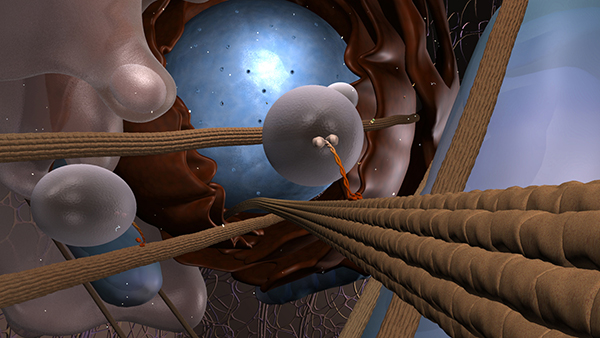Archived Content
The National Institute of Mental Health archives materials that are over 4 years old and no longer being updated. The content on this page is provided for historical reference purposes only and may not reflect current knowledge or information.
Powered-Up Probe ID’s Schizophrenia Genes That Stunt Brain Development
Public-Private Psychiatric Data Consortium Debuts Gene Expression Resource
• Science Update
Scientists have pinpointed several schizophrenia-related gene variants that alter expression of other genes in illness-implicated circuitry of the human brain. Under-expression of a few of them stunted brain development in model systems in this largest study of its kind.
The study is the first from the CommonMind Consortium (CMC) , a public-private psychiatric research data source co-founded and co-funded by NIMH. The collaboration involving pharmaceutical companies, brain banks, a foundation, and universities brought to bear the largest collection of schizophrenia postmortem brain tissue ever assembled to boost statistical power and the odds of detecting weak genetic signals.
Schizophrenia, which affects nearly one percent of the population, is known to be as much as 80-90 percent heritable, but little is known about its underlying illness processes. Genome-wide studies based on blood samples have linked genetic variation at more than 100 chromosomal sites to the illness, yet each of these confers only a small effect on risk, leaving much of schizophrenia still a mystery.
“As we move from gene discovery - which for risk genes can be done in any tissue – to the human brain, we are able to explore changes in the molecular machinery of the cell, such as gene expression and epigenetic mechanisms, that are impacted by these genetic risk factors,” explained Thomas Lehner, Ph.D., director of the NIMH Office of Genomics Research Coordination, which helped to build the Consortium and fund the project.
A team of 56 researchers, supported by 15 NIMH grants, report on their findings September 26, 2016 in the journal Nature Neuroscience.
Their study characterized genome-wide genetic variation and sequenced an indicator of gene expression, RNA , from a schizophrenia-implicated area of the brain’s executive hub, the dorsolateral prefrontal cortex, in postmortem tissue from 258 people who had schizophrenia and 279 controls. This sample dwarfed those of earlier such studies based on postmortem tissue.
Out of 108 genome sites earlier linked to the illness – schizophrenia’s “skyline” of risk loci – genetic variation at 20 sites was found to potentially regulate the expression of genes. Of those 20, five gene variants were each found to alter expression of only one gene. Experimental manipulation of three of those five genes altered brain development in model systems.
For example, depleting a protein called furin stunted head growth in zebrafish by nearly a fourth. Knocking down the FURIN gene decreased migration of human neurons derived from induced pluripotent stem cells in culture – perhaps suggesting a possible mechanism by which schizophrenia might disrupt the developing brain.
The study also found “subtle but broad disruption in transcription” of genes in schizophrenia, which the researchers say is consistent with the prevailing model of many genes contributing to risk. They also identified a sub-network of about 1,400 genes – including many in genomic sites linked to the illness – coding for components involved in communications between neurons that are “significantly perturbed” in schizophrenia.
Since its sample size was about 10-fold larger than any previous study of its kind, the new study’s much higher statistical power raises questions about some earlier findings. It suggests that some earlier studies based on small samples over-estimated the differential expression of schizophrenia risk genes. Models based on the new data estimate that to ensure enough statistical power to confidently discern differential expression of a suspect schizophrenia risk gene between cases and controls would require, on average, a huge, currently unattainable, sample size of about 28,500.
“This need for more statistical power underscores the importance of expanding resources for collections and public education about the importance of making tissue donations,” noted Lehner.

RNA molecules
Source: National Center for Advancing Translational Sciences (NCATS), National Institutes of Health
Among the brain banks participating in CMC is NIMH’s intramural Human Brain Collection Core and its director Barbara Lipska, Ph.D., is a co-author of the article. All results can be accessed via the CommonMind Knowledge Portal (CMC, www.synapse.org/cmc ).
Reference
Gene expression elucidates functional impact of polygenic risk for schizophrenia.
Fromer M, Roussos P, Sieberts SK, Johnson JS, Kavanagh DH, Perumal TM, Ruderfer DM, Oh EC, Topol A, Shah HR, Klei LL, Kramer R, Pinto D, Gümüş ZH, Cicek AE, Dang KK, Browne A, Lu C, Xie L, Readhead B, Stahl EA, Xiao J, Parvizi M, Hamamsy T, Fullard JF, Wang YC, Mahajan MC, Derry JM, Dudley JT, Hemby SE, Logsdon BA, Talbot K, Raj T, Bennett DA, De Jager PL, Zhu J, Zhang B, Sullivan PF, Chess A, Purcell SM, Shinobu LA, Mangravite LM, Toyoshiba H, Gur RE, Hahn CG, Lewis DA, Haroutunian V, Peters MA, Lipska BK, Buxbaum JD, Schadt EE, Hirai K, Roeder K, Brennand KJ, Katsanis N, Domenici E, Devlin B, Sklar P. Nat Neurosci. 2016 Sep 26. doi: 10.1038/nn.4399. [Epub ahead of print] PMID: 27668389
Grant
MH093725, MH066392, MH097276, MH075916, MH09689, MH084053, MH057881, MH057881S, MH085542, MH096296, MH066392, MH101454, MH109677, MH094268, MH074313
